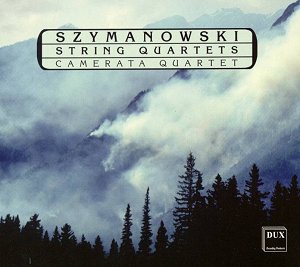Szymanowski’s are pretty
much the fons et origo of Polish string
quartets. They take the impressionist
aesthetic as near the Ravelian-Debussyian
axis as it will comfortably go (listen
to the opening of the second quartet)
and are suffused with colour and a complex
profile that ranges from archaisms and
pointillist serenity through folk influence
to bristling modernist fugato. The Polish
Camerata Quartet set down these recordings
in 2000 and I was impressed by them.
The opening of the 1917 First Quartet
is chaste and interior with an idiosyncratic
languor but also an angular toughness
less often remarked on with Szymanowski.
The Camerata cultivate colouristic expression
right from the start and they have an
excellent uniformity of bowing subtleties,
not least in this movement. They take
a flowing tempo in the second movement
compounded of andantino and bustling
scherzo. The central panel here is well
sustained at a wistfully withdrawn dynamic
range and there’s real depth in the
playing – before a folksy finale erupts.
This is full of swaying fiddles and
folk pizzicati – and a strong polytonal
drive – and ends in a throwaway final
couple of bars, ambiguous in its ultimate
significance.
That Ravel haunts the
opening of the 1927 Quartet is I think
indisputable but the use to which Szymanowski
puts his models is the more important
factor. The Camerata manage Szymanowski’s
exposed harmonics well – good intonation
– and the collective tonal blend is
always convincing. They are especially
good in the folk dance of the Vivace
scherzando second movement with perky
"up and down" string figures
and the seamless slowing down for the
reflective intimacies of the contrastive
material. The Camerata also hint at
the uneasy unison writing later in the
movement where the quartet reminds one
less of Ravel now than Bartók.
From the launch pad of the little Lento
introduction the Camerata drive the
finale to an intense and determined
conclusion.
There’s some considerable
competition in the catalogue in these
quartets not least because this Dux
disc lasts only thirty-five minutes,
a fact I feel constrained to point out.
The Maggini Quartet couple their recording
of the quartets with the Fourth of Grazyna
Bacewicz, brilliant programming, and
the Varsovia Quartet include Lutosławski’s
and Penderecki’s Second. Meanwhile the
Carmina include Webern’s Langsamer Satz
though it’s is probably less compelling
as a coupling. I admired the Camerata’s
playing – if timing considerations are
against them I don’t think you’ll be
disappointed by the performances.
Jonathan Woolf
